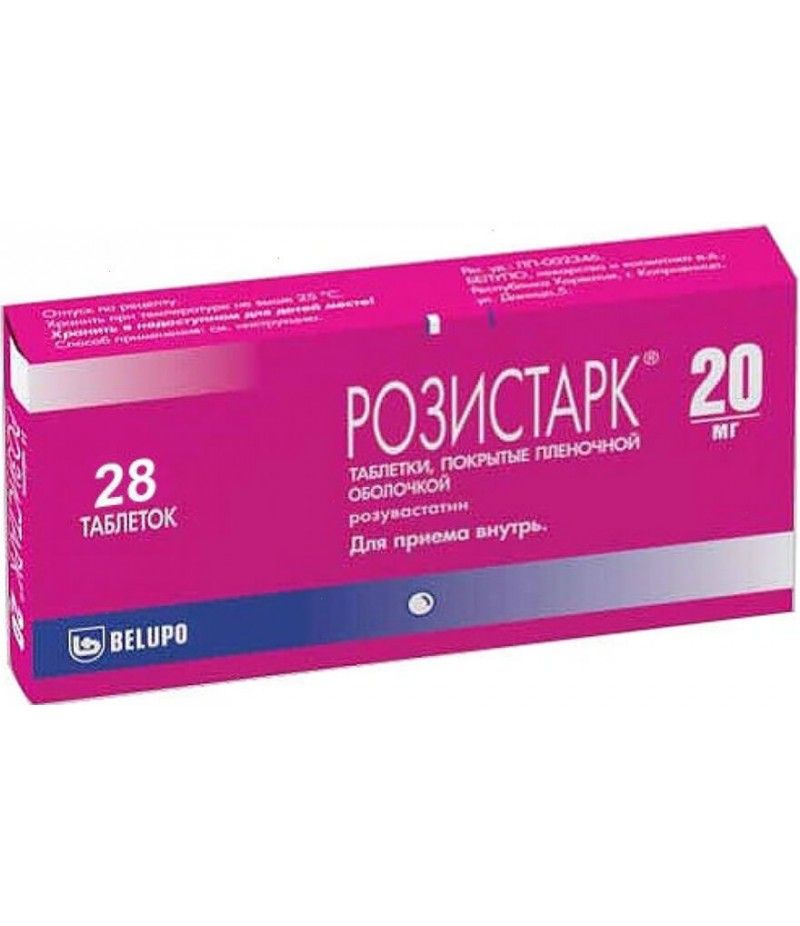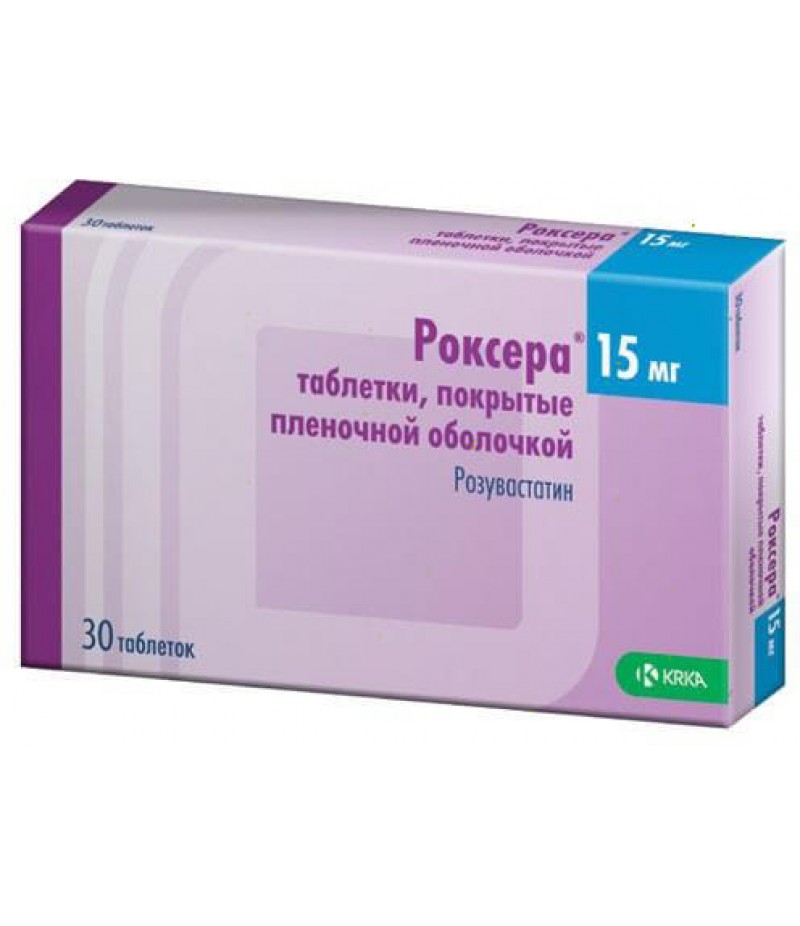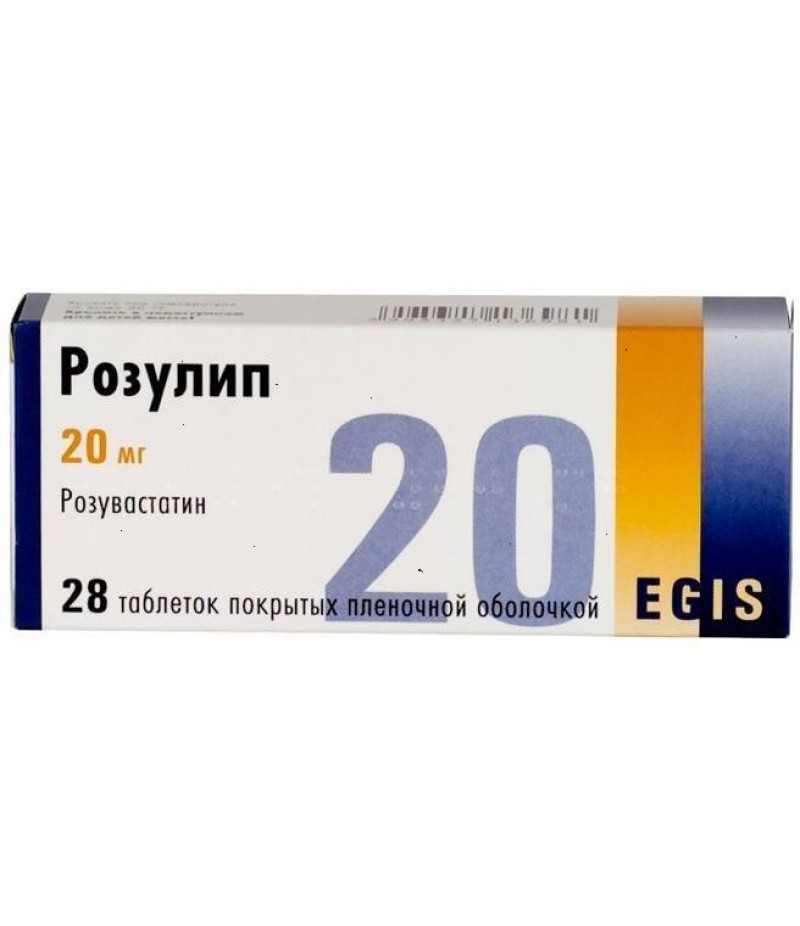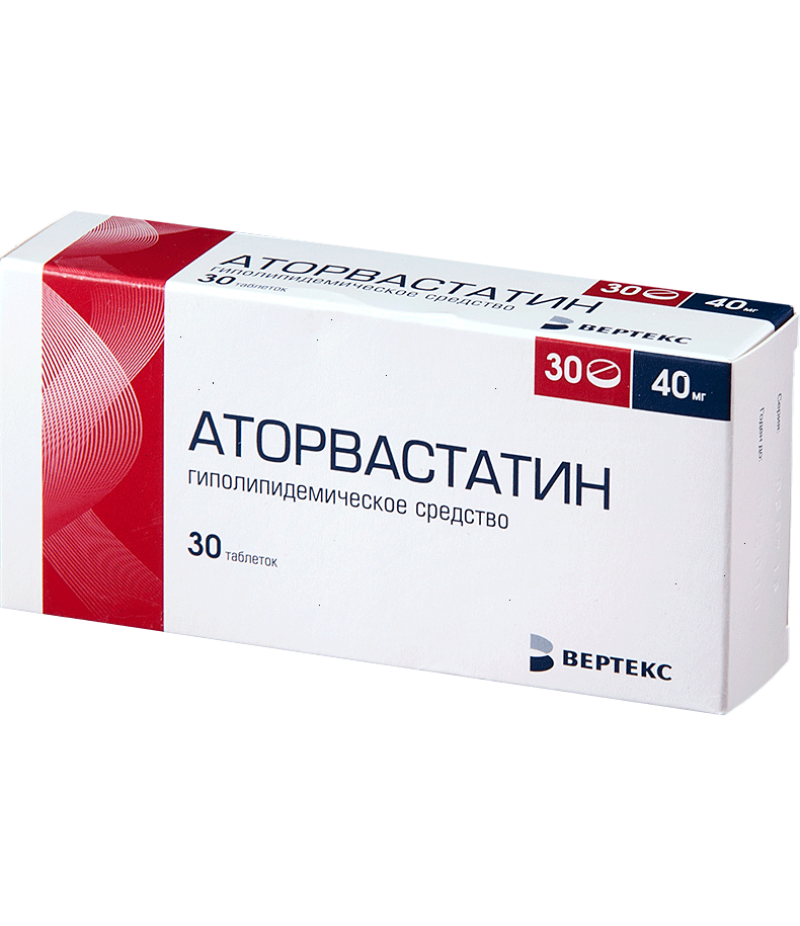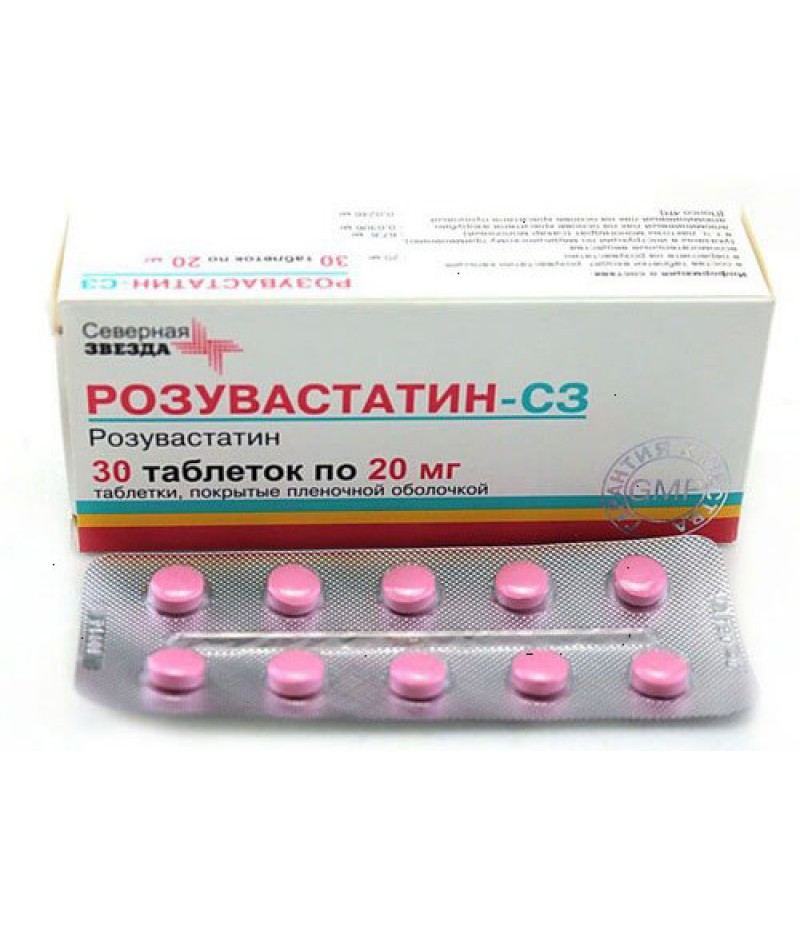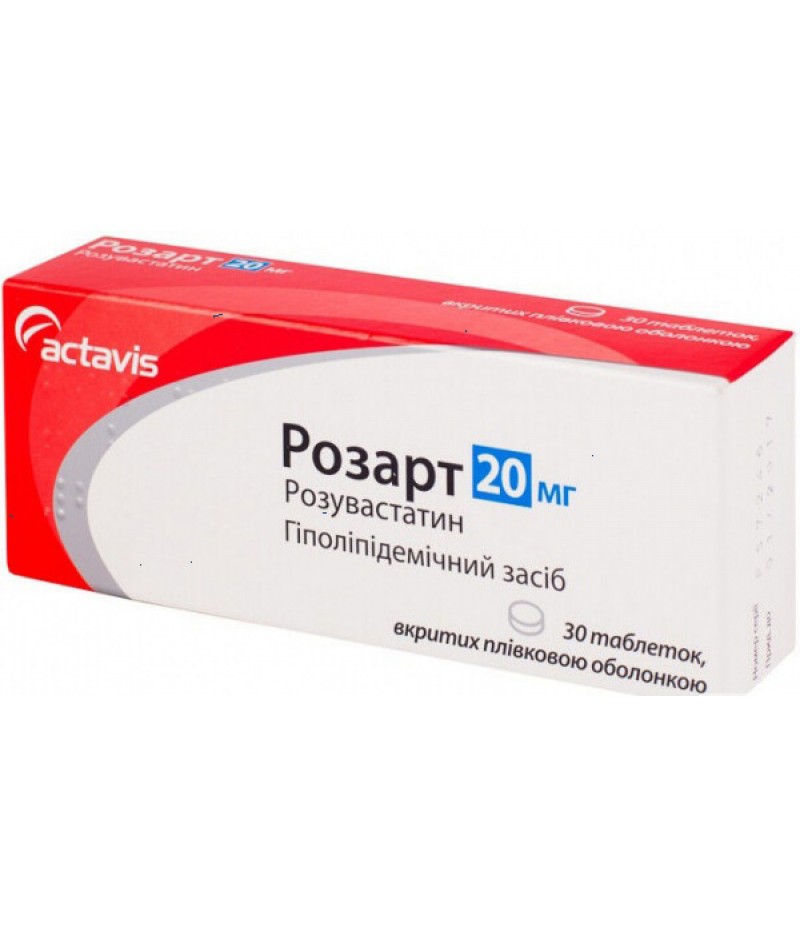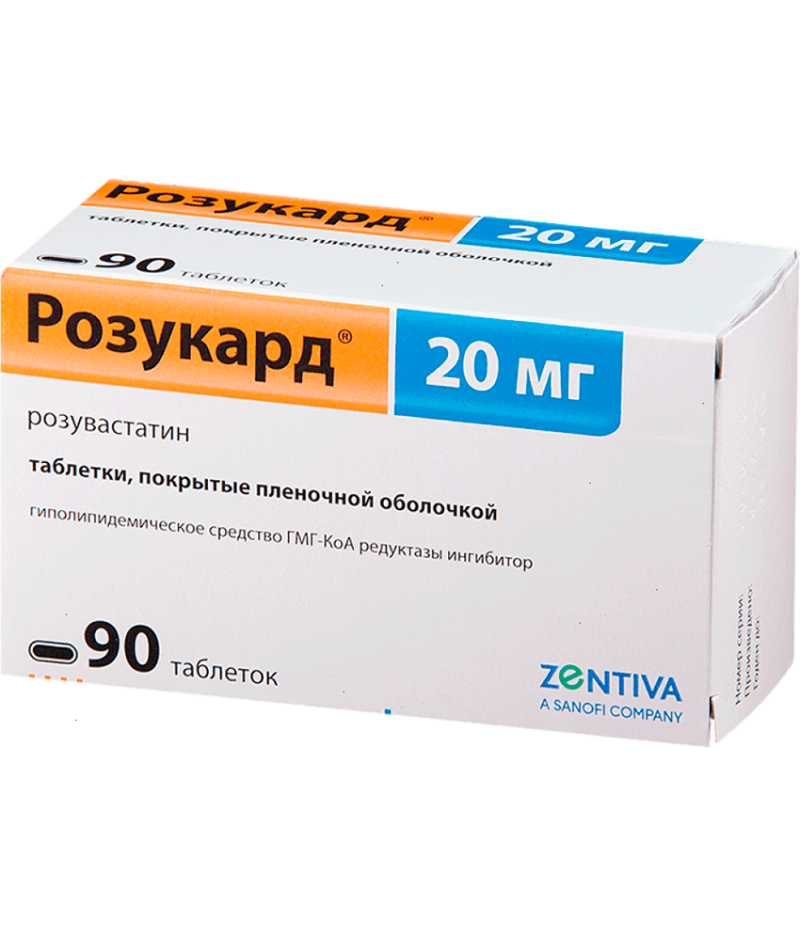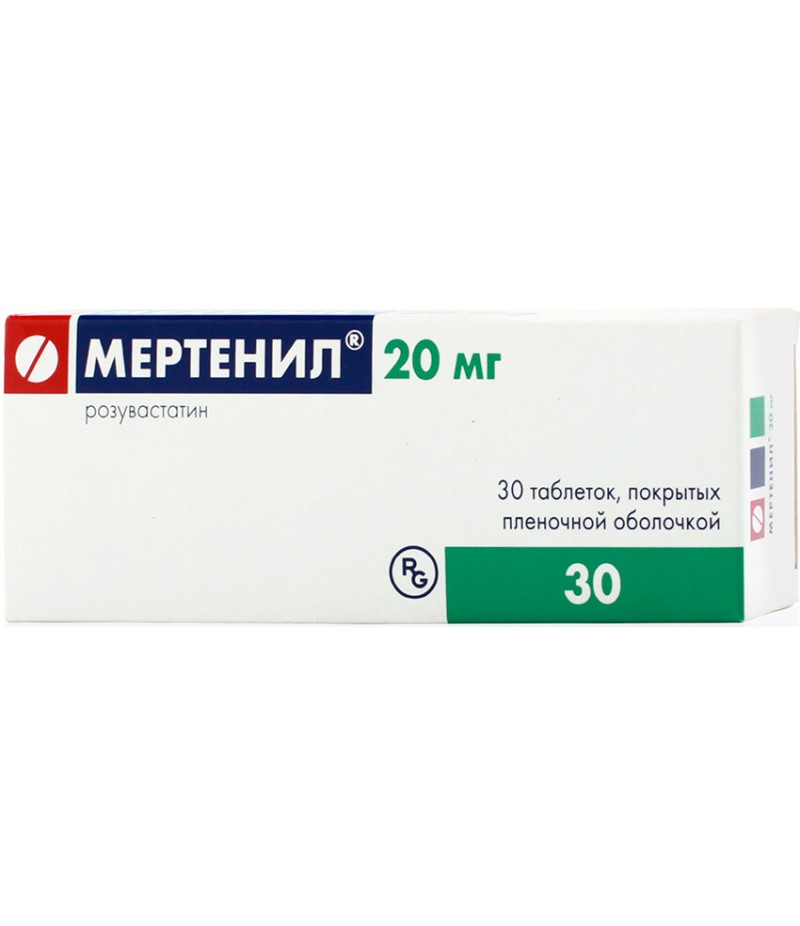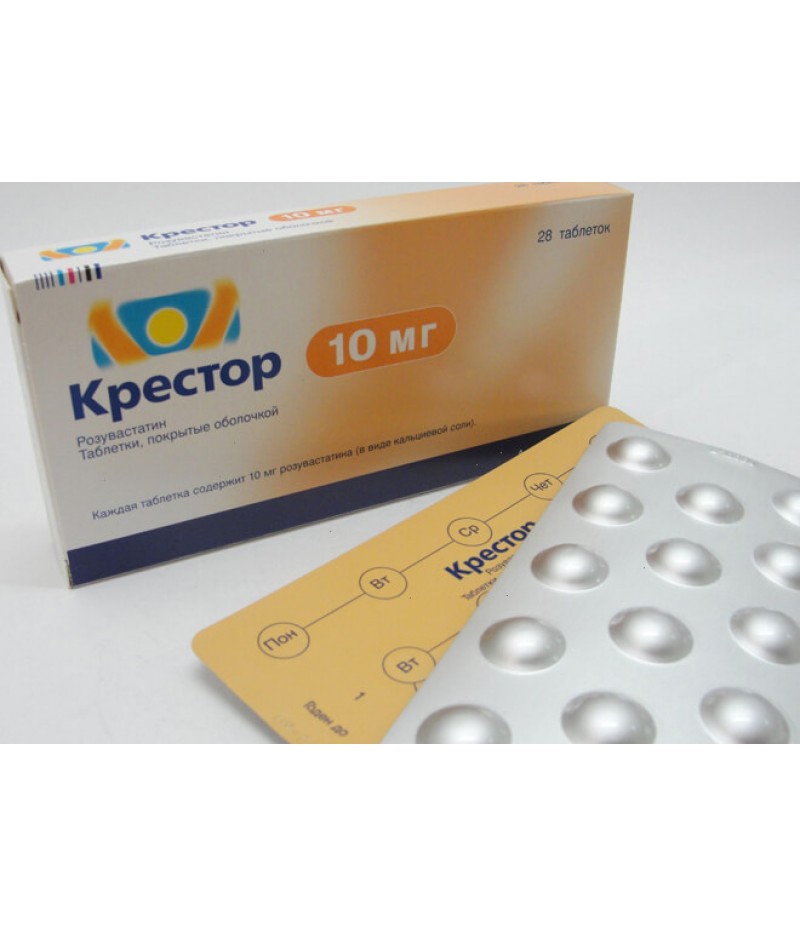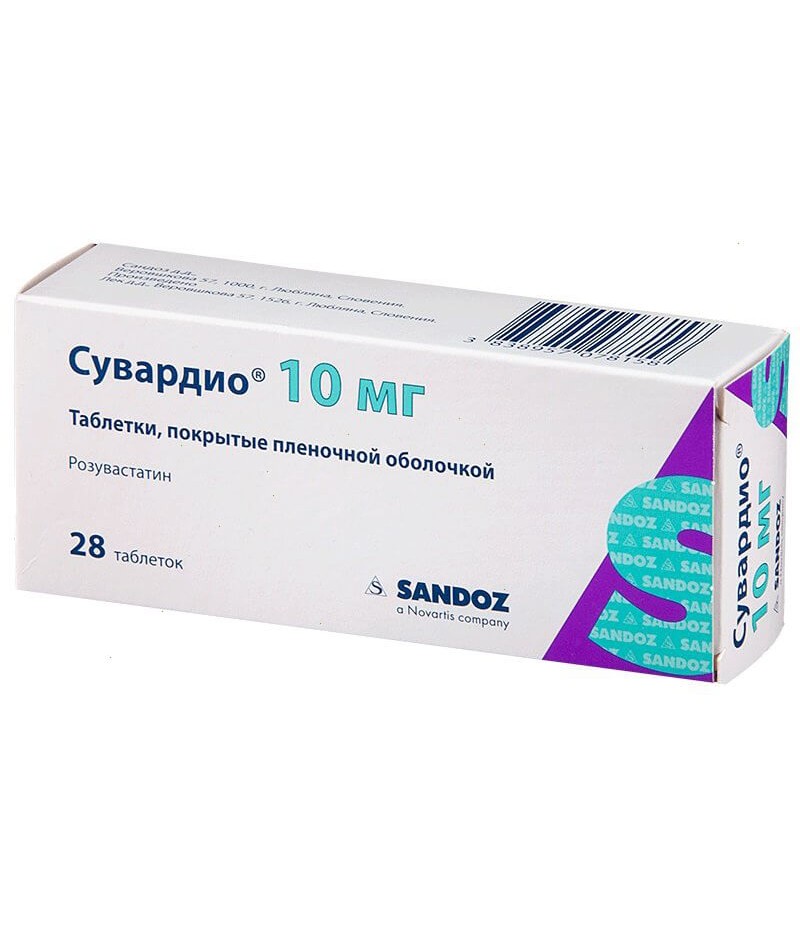Rozistark tabs 20mg #28
- $39.99$43.50
- Availability:In Stock
Rozistark instructionYou can buy Rozistark hereCompositionOne tablet, film coated, contains:Active ingredient: rosuvastatin 10 mg, 20 mg or 40 mg in the form of rosuvastatin calcium 10.4000 mg, 20.8000 mg or 41.6000 mg, respective..
Tags: tabs
Rozistark instruction
You can buy Rozistark here
Composition
One tablet, film coated, contains:
Active ingredient: rosuvastatin 10 mg, 20 mg or 40 mg in the form of rosuvastatin calcium 10.4000 mg, 20.8000 mg or 41.6000 mg, respectively.
Excipients: lactose monohydrate - 89.6400 / 179.2800 / 229.6450 mg, microcrystalline cellulose - 42.6850 / 85.3700 / 109.3550 mg, crospovidone - 6.0000 / 12.0000 / 16.0000 mg, magnesium stearate - 1.2750 / 2.5500 / 3.4000 mg;
tablet shell: lactose monohydrate - 1.8000 / 3.6000 / 4.8000 mg, hypromellose - 1.2600 / 2.5200 / 3.3600 mg, titanium dioxide - 1.0778 / 2.1555 / 2.8740 mg, triacetin - 0.3600 / 0.7200 / 0.9600 mg, quinoline yellow - 0.0022 / 0.0045 / 0.0060 mg.
Description
10 mg: Round, biconvex tablets, film-coated, from light yellow to yellow color, with an engraving "10" on one side and "15" on the other side.
20 mg: Round, biconvex tablets, film-coated, from light yellow to yellow color, with an engraving "20" on one side and "15" on the other side.
40 mg: Round, biconvex tablets, film-coated, from light yellow to yellow color, with an engraving "40" on one side and "15" on the other side.
Pharmacotherapeutic group:
hypolipidemic agent - HMG-CoA reductase inhibitor
ATX code [C10AA07]
Mechanism of action
Rosuvastatin is a selective, competitive inhibitor of HMG-CoA reductase, an enzyme that converts 3-hydroxy-3-methylglutaryl coenzyme A to mevalonic acid, which is a precursor of cholesterol. The main target of rosuvastatin is the liver, where cholesterol (cholesterol) synthesis and low density lipoprotein catabolism (LDL) are performed.
Rosuvastatin increases the number of “liver” LDL receptors on the cell surface, increasing the uptake and catabolism of LDL, which leads to inhibition of the synthesis of very low density lipoproteins (VLDL), thereby reducing the total number of LDL and VLDL.
Pharmacodynamics
Rosuvastatin reduces elevated cholesterol-LDL (cholesterol-LDL), total cholesterol and triglycerides (TG), increases the concentration of high-density cholesterol-lipoprotein (cholesterol-HDL cholesterol), and also reduces the concentration of apolipoprotein B (ApoB), cholesterol-LDLP, cholesterol VLDL, triglycerides, VLDL and increases the concentration of apolipoprotein A-I (ApoA-I), decreases the ratio of LDL-C / HDL-C, total cholesterol / cholesterol-HDL cholesterol and LDL-neLPVP / HDL cholesterol and the ratio of apoB / ApoA-I.
The therapeutic effect develops within one week after the start of therapy with Rozistark, after 2 weeks of treatment reaches 90% of the maximum possible effect.
The maximum therapeutic effect is usually achieved after 4 weeks of treatment and is maintained with further regular use of the drug.
Clinical efficacy
Rosuvastatin is effective in adult patients with hypercholesterolemia with or without symptoms of hypertriglyceridemia, regardless of their race, gender, or age, as well as in treating patients with diabetes and the hereditary form of familial hypercholesterolemia.
Rosuvatatin is effective in patients with hypercholesterolemia IIa and IIb type according to Fredrickson (the average initial concentration of LDL-C is about 4.8 mmol / l). In 80% of these patients who received 10 mg of rosuvastatin, the concentration reaches the target values of cholesterol-LDL levels established by the European Community for the study of atherosclerosis - less than 3 mmol / l. Patients with heterozygous familial hypercholesteridemia who took rosuvastatin in doses of 20 to 80 mg show a positive trend in lipid profile parameters.
As a result of titration of doses up to a daily dose of 40 mg (12 weeks of therapy), a decrease in the concentration of LDL-C by 53% is noted. In 33% of patients, the concentration of cholesterol-LDL is less than 3 mmol / l, which corresponds to the target standards of the European atherosclerosis research guidelines.
In patients with homozygous familial hypercholesterolemia who took rosuvastatin in doses of 20 and 40 mg, the average decrease in the concentration of LDL-C is 22%.
In patients with hypertriglyceridemia with an initial TG concentration of 273 to 817 mg / dL, taking rosuvastatin at a dose of 5 mg to 40 mg once a day for six weeks, the concentration of TG in the blood plasma significantly decreased.
An additive effect is observed in combination with fenofibrate in relation to the TG content and with nicotinic acid (more than 1 g per day) in relation to the content of HDL-C. In patients with a low risk of developing coronary heart disease (CHD) (10-year risk on the Framingham scale less than 10%), with an average concentration of LDL-C of 4.0 mmol / l (154.5 mg / dL) and subclinical atherosclerosis, which estimated by the thickness of the intima-media complex of the carotid arteries - TCIM; rosuvastatin at a dose of 40 mg / day significantly slowed the rate of progression of the maximum TCIM for 12 segments of the carotid artery compared with placebo with a difference of 0.0145 mm / year (95% confidence interval (CI): from -0.0,0196 to -0.0093; p The results of the study p about the use of statins for primary prophylaxis showed that rosuvastatin significantly reduced the risk of cardiovascular complications with a 44% decrease in relative risk. Efficacy of treatment was noted after 6 months of Rozistark use. A statistically significant decrease of 48% in the combined criterion was noted -vascular diseases, stroke and myocardial infarction, a 54% reduction in the occurrence of a fatal or nonfatal myocardial infarction and a 48% decrease in a fatal or nonfatal stroke. Total mortality decreased by 20% in the rosuvastatin group. The safety profile of patients taking rozuvastatin at a dose of 20 mg was similar to the safety profile in the placebo group.
Pharmacokinetics
Absorption and distribution
The maximum concentration of rosuvastatin in the blood plasma is reached 5 hours after ingestion. Absolute bioavailability is approximately 20%.
Rosuvastatin is metabolized mainly by the liver, which is the main site of cholesterol synthesis and metabolism of LDL-C. The volume of distribution of rosuvastatin is approximately 134 liters. About 90% of rosuvastatin binds to plasma proteins, mainly albumin.
Metabolism
Subject to limited metabolism (about 10%). Rosuvastatin is a rather non-core substrate for metabolism by cytochrome P450 isoenzymes. CYP2C9 is the main isoenzyme involved in rosuvastatin metabolism, while CYP2C19, CYP3A4 and CYP2D6 isoenzymes are less involved in metabolism. The main identified metabolites of rosuvastatin are N-desmethylrozuvastatin, which is 50% less active than rosuvastatin, and lactone metabolites, which are pharmacologically inactive. More than 90% of the pharmacological activity on inhibition of circulating HMG-CoA reductase is provided by rosuvastatin, the rest is provided by its metabolites.
Removal
Approximately 90% of the dose of rosuvastatin taken is excreted unchanged through the intestines (including absorbed and unabsorbed rosuvastatin), the rest is excreted by the kidneys. The half-life (T1 / 2) is approximately 19 h.
The half-life does not change with increasing dose of the drug. The geometric mean plasma clearance is approximately 50 l / h (coefficient of variation 21.7%). As with other inhibitors of HMG-CoA reductase, membrane cholesterol transporter is involved in the process of hepatic uptake of rosuvatatin, which plays an important role in the hepatic elimination of rosuvastatin.
Linearity
The systemic exposure of rosuvastatin increases in proportion to the dose. Changes in pharmacokinetic parameters when taking Rozistark several times a day is not observed.
Age and gender
Gender and age do not have a clinically significant effect on the pharmacokinetic parameters of rosuvastatin.
Ethnic groups
Comparative pharmacokinetic studies showed an approximately twofold increase in the mean AUC (area under the concentration-time curve) and Cmax (time to reach the maximum plasma concentration of the drug) in patients of Mongoloid race (Japanese, Chinese, Filipinos, Vietnamese and Koreans) compared to indicators of the representatives of the Caucasoid race. Indians had an increase in the average value of AUC and Cmax by about 1.3 times. Pharmacokinetic analysis revealed no clinically significant differences in pharmacokinetics among the Caucasians and Negroids.
Renal failure
In patients with mild to moderate renal failure, the plasma concentration of rosuvastatin or N-dismethylrosuvastatin does not change significantly. In patients with severe renal insufficiency (creatinine clearance (CK) less than 30 ml / min), plasma concentration of rosuvastatin is 3 times higher, and the concentration of N-dismethylrozuvastatin is 9 times higher than in healthy volunteers.
The plasma concentration of rosuvastatin in hemodialysis patients was approximately 50% higher than in healthy volunteers.
Liver failure
In patients with various stages of liver failure with a score of 7 and below on the Child-Pugh scale, no increase in the half-life of rosuvastatin was found. However, in 2 patients with 8th and 9th grades on the Child-Pugh scale, there was an increase in the half-life of about 2 times. Experience with rosuvastatin in patients with more than 9 points on the Child-Pugh scale is absent.
Genetic polymorphism
HMG-CoA reductase inhibitors, including Rozistark, bind to OATP1B1 transport proteins (a polypeptide of transport of organic anions involved in the capture of statins by hepatocytes) and BCRP (efflux transporter). In carriers of the SLCO1B1 (OATP1B1) p.521CC and ABCG2 (BCRP) p.421AA genotypes, there was an increase in exposure (AUC) to rosuvastatin 1.6 and 2.4 times, respectively, compared with the SLCO1B1 c.521TT and ABCG2 genotypes .421CC.
Indications for use
Primary hypercholesterolemia according to Fredrickson's classification (type IIa, including familial heterozygous hypercholesterolemia) or mixed hypercholesterolemia (type IIb) as a supplement to the diet when diet and other non-drug therapies (eg, exercise, weight loss) are insufficient.
Familial homozygous hypercholesterolemia as an adjunct to diet and other lipid-lowering therapy (for example, LDL-apheresis) or in cases when such therapy is not sufficiently effective.
Hypertriglyceridemia (type IV by Fredrickson classification) as a supplement to the diet.
To slow the progression of atherosclerosis as a supplement to the diet in patients who have been shown therapy to reduce the concentration of total cholesterol and LDL-C.
Primary prevention of major cardiovascular complications (stroke, myocardial infarction, arterial revascularization) in adult patients without clinical signs of coronary heart disease, but with an increased risk of its development (women older than 50 years for men and older than 60 years for women, increased concentration of C-reactive protein (≥ 2 mg / l) in the presence of at least one of the additional risk factors such as hypertension, low concentration of HDL-C, smoking, family history of early development of CHD).
Contraindications for Rozistark
For tablets 10 and 20 mg
hypersensitivity to rosuvastatin or any of the components of the drug;
liver diseases in the active phase, including a persistent increase in the activity of serum transaminase activity and any increase in serum transaminase activity by more than 3 times compared with the upper limit of normal;
severe renal failure (CC less than 30 ml / min);
myopathy;
simultaneous administration of cyclosporine;
in patients predisposed to the development of myotoxic complications;
pregnancy and breastfeeding;
in women of childbearing age who do not use reliable contraception;
an increase in the concentration of creatine phosphokinase (CPK) in the blood is more than 5 times compared with the upper limit of the norm;
concomitant use with HIV protease inhibitors;
age under 18 years (efficacy and safety not established);
lactose intolerance, lactase deficiency or glucose-galactose malabsorption (because the drug contains lactose).
For 40 mg tablets
hypersensitivity to rosuvastatin or any of the components of the drug;
liver diseases in the active phase, including a persistent increase in the activity of serum transaminase activity and any increase in serum transaminase activity by more than 3 times compared with the upper limit of normal;
moderate renal failure (CC less than 60 ml / min);
myopathy;
simultaneous administration of cyclosporine;
myotoxicity in patients receiving other HMG-CoA reductase inhibitors or a history of fibrates;
hypothyroidism;
personal or family history of muscular disease;
excessive drinking;
conditions that can lead to increased plasma concentrations of rosuvastatin;
simultaneous reception of fibrates;
pregnancy and breastfeeding;
in women of childbearing age who do not use reliable contraception;
an increase in the concentration of creatine phosphokinase (CPK) in the blood is more than 5 times as compared with the upper limit of the norm;
concomitant use with HIV protease inhibitors;
a Mongoloid patient;
age under 18 years (efficacy and safety not established);
lactose intolerance, lactase deficiency or glucose-galactose malabsorption (because the drug contains lactose).
Carefully
For tablets 10 and 20 mg
The risk of myopathy / rhabdomyolysis - renal failure, hypothyroidism; a personal or family history of hereditary muscular diseases and a previous history of muscular toxicity with other HMG-CoA reductase inhibitors or fibrates; excessive drinking; conditions in which there is an increase in the plasma concentration of rosuvastatin; age over 70 years; history of liver disease; sepsis; hypotension; extensive surgical interventions; injuries; severe metabolic, endocrine, or water-electrolyte disorders; uncontrolled epilepsy; race (mongoloid race); simultaneous reception of fibrates; simultaneous use with colchicine and ezetimibe.
For 40 mg tablets
Renal failure of moderate severity (CC more than 60 ml / min); age over 70 years; history of liver disease; sepsis; hypotension; extensive surgical interventions; injuries; severe metabolic, endocrine, or water-electrolyte disorders; uncontrolled epilepsy; simultaneous use with colchicine and ezetimibe.
Patients with liver failure
Data on the use of the drug in patients with more than 9 points on the Child-Pugh scale are not available.
Use during pregnancy and during breastfeeding
Rozistark is contraindicated during pregnancy and during breastfeeding.
Women of reproductive age should use reliable and adequate methods of contraception.
Since cholesterol and other cholesterol biosynthesis products are of great importance for the development of the fetus, the potential risk of inhibition of HMG-CoA reductase exceeds the benefits of the use of the drug in pregnant women.
If pregnancy is diagnosed during therapy, the drug should be immediately discontinued.
There is no data on the release of rosuvastatin with breast milk, therefore, during breastfeeding, the use of the drug should be discontinued.
Dosage and administration
Inside, do not chew or crush the pill, swallow whole, washed down with water.
The drug can be used at any time of the day, regardless of the meal.
Before starting treatment, the patient should begin to follow a diet with foods that are low in cholesterol, which should be continued throughout the entire treatment period. The dose of the drug should be chosen individually depending on the goals of therapy and the therapeutic response to treatment, taking into account modern generally accepted recommendations on target lipid concentrations.
If you need to take the drug in a dose of 5 mg, you can use the drug rosuvastatin in another dosage form or dosage, for example, 5 mg tablets or 10 mg tablets with a risk (a tablet at a dose of 10 mg should be divided into two parts according to the risk).
The recommended initial dose of the drug is 5 mg or 10 mg 1 time per day, both for patients who have not previously taken statins, and for patients who have been transferred to taking this drug after therapy with other HMG-CoA reductase inhibitors. When choosing the initial dose, cholesterol levels should be taken into account in each individual patient and the possible risk of cardiovascular complications should be taken into account, as well as the potential risk of side effects should be evaluated. If necessary, after 4 weeks the dose may be increased.
Due to the possible development of side effects when taking a dose of 40 mg compared with lower doses of the drug (see the “Side Effects” section), increasing the dose to 40 mg after an additional dose of the drug is higher than the recommended initial dose within 4 weeks of therapy , can be performed only in patients with severe hypercholesterolemia and with a high risk of cardiovascular complications (especially in patients with hereditary hypercholesterolemia) in whom the desired result was not achieved when taking a dose of 20 mg. apes, and which will be under the supervision of a physician (see section “Special Instructions”). At purpose of a dose of 40 mg careful observation of the patient is recommended. It is not recommended to prescribe a dose of 40 mg to patients who have not previously visited a doctor.
After 2-4 weeks of therapy and / or with an increase in the dose of the drug, monitoring of lipid metabolism indices is necessary; if necessary, the dose should be adjusted.
The dose of the drug should be adjusted, if necessary, its joint use with drugs that increase the exposure to rosuvastatin.
If exposure is expected to increase by 2 times or more, the initial dose of the drug should be 5 mg once a day. The maximum daily dose of the drug should also be adjusted so that the expected exposure to rosuvastatin does not exceed that for a dose of 40 mg taken without simultaneous prescription of drugs interacting with rosuvastatin (see the section "Interaction with other drugs" Table 1).
Elderly patients
No dose adjustment required.
Patients with renal failure
In patients with mild or moderate renal insufficiency, dose adjustment is not required. In patients with severe renal failure (CC less than 30 ml / min), the use of the drug is contraindicated. The drug at a dose of 40 mg is contraindicated in patients with moderate renal dysfunction (CC 30-60 ml / min). Patients with moderate renal impairment are recommended an initial dose of 5 mg.
Patients with liver failure
The drug is contraindicated in patients with liver disease in the active phase (see section "Contraindications").
Ethnic groups
In Mongoloid patients, an increase in the systemic concentration of rosuvastatin is possible. This fact should be taken into account when prescribing the drug to these groups of patients. When prescribing doses of 10 mg and 20 mg, the recommended initial dose of the drug for patients of the Mongoloid race is 5 mg. The use of the drug in a dose of 40 mg is contraindicated in such patients (see section "Contraindications").
Genetic polymorphism
In carriers of the SLCO1B1 genotypes (OATP1B1) p.521CC and ABCG2 (BCRP) p.421AA, there was an increase in exposure (AUC) to rosuvastatin compared to carriers of the SLCO1B1 genotypes c.521TT and ABCG2 p.421CC. For patients who carry genotypes p.521CC or p.421AA, the recommended maximum dose of Rozistark is 20 mg 1 time per day (see the sections “Pharmacokinetics”, “Special Instructions”, and “Interaction with Other Drugs”).
Patients predisposed to myopathy
When prescribing doses of 10 mg and 20 mg, the recommended initial dose for patients with a predisposition to myopathy is 5 mg. The use of the drug in a dose of 40 mg is contraindicated in such patients.
Concomitant therapy
Rosuvastatin binds to various transport proteins, in particular with OATP1B1 and BCRP. When Rozistark is used together with medications such as cyclosporine, some HIV protease inhibitors, including a combination of ritonavir with atazanavir, lopinavir and / or tipranavir, increase the concentration of rosuvastatin in the plasma due to interaction with transport proteins, myopathy may increase, including rhabdomyolysis (see sections “Special Instructions” and “Interaction with Other Medicines”).
In such cases, you should evaluate the possibility of prescribing alternative therapy or temporary cessation of taking Rozistark. If the use of the above preparations is necessary, the ratio of the benefits and risks of concomitant therapy with Rozistark should be evaluated and the possibility of reducing its dose should be considered (see the section “Interaction with other drugs”).
Side effect
The side effects associated with taking Rozistark are usually moderately severe and disappear on their own. The frequency of side effects is mainly dose-dependent, as with the use of other inhibitors of HMG-CoA reductase.
The following classification is used to designate the frequency of side effects: often (? 1/100 and? 1/10), infrequently (? 1/1000 and? 1/100), rarely (? 1/10000 and? 1/1000), very rarely (? 1/10000), unspecified frequency (cannot be calculated from the available data).
From the skin:
infrequently: pruritus, rash, urticaria;
unspecified frequency: Stevens-Johnson syndrome.
From the digestive tract:
often: constipation, nausea, abdominal pain;
rarely: pancreatitis;
very rarely: jaundice, hepatitis;
unspecified frequency: diarrhea.
From the side of the central nervous system:
often: headache, dizziness;
very rare: polyneuropathy, memory loss.
On the part of the immune system:
seldom: hypersensitivity, including angioedema.
On the part of the endocrine system:
often: type 2 diabetes.
Other:
often: asthenic syndrome;
unspecified frequency: peripheral edema.
From the musculoskeletal system:
often: myalgia;
rarely: myopathy (including myositis), rhabdomyolysis;
very rarely: arthralgia;
unspecified frequency: immune-mediated necrotizing myopathy.
Actions on skeletal muscles that cause myalgia, myopathy (including myositis) and, in rare cases, rhabdomyolysis with or without the development of acute renal failure, were observed in patients taking any dose of rosuvastatin, especially when taking doses exceeding 20 mg. A dose-dependent increase in the activity of creatine phosphokinase (CPK) was detected in patients taking rosuvastatin, but in most cases these manifestations were minor, asymptomatic and transient. In the case of increased activity of CPK more than 5 times compared with the upper limit of the norm, therapy should be suspended (see the section “Special Instructions”).
On the part of the urinary system
When receiving rosuvastatin, proteinuria can be observed. Changes in the protein content in the urine (from the absence or presence of trace amounts to ++ and above) are observed in less than 1% of patients taking rosuvastatin at a dose of 10 mg and 20 mg, and about 3% of patients taking the drug at a dose of 40 mg . A slight change in the amount of protein in the urine, expressed in the change from the zero level or the presence of traces to the level of +, was observed when taking the drug in a dose of 20 mg. In most cases, proteinuria decreased and independently passed on during the treatment. When analyzing data from clinical studies, no causal relationship was found between proteinuria and acute or progressive kidney disease.
Very rarely: hematuria, microhematuria.
Liver
With the use of rosuvastatin, there is a dose-dependent increase in the activity of “liver” transaminases in a small number of patients. In most cases, this increase is insignificant, asymptomatic and temporary.
Laboratory values
When using rosuvastatin, the following changes in laboratory parameters were observed: an increase in the concentration of glucose, bilirubin, the activity of gamma-glutamyl transpeptidase, alkaline phosphatase, dysfunction of the thyroid gland.
From the hemopoietic system:
unspecified frequency: thrombocytopenia.
On the part of the respiratory system:
unspecified frequency: cough, shortness of breath.
On the part of the reproductive system and the breast:
unspecified frequency: gynecomastia.
When using certain statins, the following side effects were reported: depression, sleep disorders, including insomnia and nightmares, sexual dysfunction.
With prolonged use of rosuvastatin, isolated cases of interstitial lung disease have been reported.
Overdose
There is no specific treatment for an overdose of rosuvastatin. In case of overdose, it is recommended to carry out symptomatic treatment and support functions of vital organs and systems of the event. Liver function and CPK activity should be monitored. Hemodialysis in this case is probably ineffective.
Interaction Rozistark with other drugs
Effect of the use of other drugs on rosuvastatin
Transport protein inhibitors: Rosuvastatin binds to certain transport proteins, in particular, OATP1B1 and BCRP. The concomitant use of drugs that are inhibitors of these transport proteins may be accompanied by an increase in plasma concentration of rosuvastatin and an increased risk of myopathy (see Table 1 and the sections "Dosage and administration" and "Special instructions").
Cyclosporine: with the simultaneous use of rosuvastatin and cyclosporine, the AUC of rosuvastatin increased by 7 times compared with the values obtained in healthy volunteers (see section "Contraindications"). The combined use leads to an increase in the concentration of rosuvastatin in the blood plasma by 11 times. The simultaneous use of drugs does not affect the concentration of cyclosporine in the blood plasma.
Ezetimibe: with the simultaneous use of rozuvastatin and ezetimibe, there is no change in the AUC or Cmax of both drugs. However, the risk of side effects due to the pharmacodynamic interaction between rosuvastatin and ezetimib cannot be ruled out.
Gemfibrozil and other lipid-lowering drugs: the simultaneous use of rosuvastatin and gemfibrozil leads to a 2-fold increase in Cmax and AUC of rosuvastatin (see the section "Special Instructions"). Based on the research data on specific interactions, no pharmacokinetically significant interaction with fenofibrate is expected, however, pharmacodynamic interaction is possible. Gemfibrozil, fenofibrate, other fibrates and nicotinic acid in lipid-lowering doses (1 g or more per day) while being used with HMG-CoA reductase inhibitors increased the risk of myopathy, possibly due to the fact that they can cause myopathy and when used as monotherapy. Simultaneous intake of 40 mg of rosuvastatin and fibrates is contraindicated (see the section "Special Instructions" and "Contraindications"). At the same time taking the drug with gemfibrozil and other lipid-lowering agents in a dose of more than 1 g / day, the initial dose of Rozistark should not exceed 5 mg.
HIV protease inhibitors: although the exact mechanism of interaction is unknown, the concomitant use of rosuvastatin with HIV protease inhibitors can lead to a significant increase in the exposure of rosuvastatin. In a pharmacokinetic study, while taking 20 mg of rozuvastatin and a combined preparation containing two HIV protease inhibitors (400 mg of lopinavir / 100 mg of ritonavir) in healthy volunteers, an increase of 2 times AUC (0-24) and 5 times Cmax of rosuvastatin was detected. Therefore, simultaneous administration of rosuvastatin and HIV protease inhibitors in the treatment of patients with HIV is not recommended.
Antacids: the concomitant use of rosuvastatin and suspensions of antacids containing aluminum or magnesium hydroxide can lead to a decrease in the concentration of rosuvastatin in the blood plasma by about 50%. This effect is less pronounced if antacids are applied 2 hours after taking rosuvastatin. The clinical significance of this interaction has not been studied.
Erythromycin: the concomitant use of rosuvastatin and erythromycin can lead to a decrease in AUC (0-t) of rosuvastatin by 20% and Cmax of rosuvastatin by 30%. Such an interaction can be caused by increased intestinal motility, caused by taking erythromycin.
Cytochrome P450 isoenzymes: the results of in vitro and in vivo studies have shown that rosuvastatin is neither an inhibitor nor an inducer of cytochrome P450 isoenzymes. In addition, rosuvastatin is a fairly weak substrate for these isoenzymes. There was no clinically significant interaction between rosuvastatin and fluconazole (an inhibitor of CYP2C9 and CYP3A4 isoenzymes) and ketoconazole (an inhibitor of CYP2A6 and CYP3A4 isoenzymes). The current use of rosuvastatin and itraconazole (an inhibitor of the isoenzyme CYP3A4) increases the AUC of rosuvastatin by 28% (clinically significant). Therefore, any interaction of drugs associated with the metabolism of cytochrome P450 is not expected.
Colchicine: cases of myopathy, including rhabdomyolysis, have been reported with the simultaneous use of HMG-CoA reductase inhibitors, including rosuvastatin, and colchicine.
The effect of rosuvastatin on other drugs
Vitamin K antagonists: as is the case with other HMG-CoA reductase inhibitors, starting rosuvastatin therapy or increasing the drug dose in patients receiving indirect anticoagulants at the same time (for example, warfarin or other coumarin anticoagulants) can lead to an increase in prothrombin time (international normalized ratio) - INR). Canceling rosuvastatin or reducing the dose may cause a decrease in INR. In such cases, an INR should be monitored.
Oral contraceptives / hormone replacement therapy:
the concomitant use of rosuvastatin and oral contraceptives may lead to an increase in the AUC of ethinyl estradiol and norgestrel by 26% and 34%, respectively. Such an increase in plasma concentration should be considered when choosing a dose of oral contraceptives. Pharmacokinetic data on the simultaneous use of rozuvastatin and hormone replacement therapy are not available, therefore, a similar effect cannot be ruled out when using this combination. However, this combination of drugs was widely used in clinical trials and was well tolerated by patients.
Other drugs: no clinically significant interaction is expected with simultaneous use of rosuvastatin and digoxin.
Drug interactions that require dose adjustment of rosuvastatin (see Table 1).
The dose of the drug Rozistark should be adjusted if necessary, its joint use with drugs that increase the exposure to rosuvastatin. If exposure is expected to increase by 2 times or more, the initial dose of Rozistark should be 5 mg 1 time per day. The maximum daily dose of Rozistark should also be adjusted so that the expected exposure to rosuvastatin does not exceed that for a dose of 40 mg taken without the simultaneous administration of drugs interacting with rosuvastatin. For example, the maximum daily dose of Rozistark with simultaneous use with gemfibrozil is 20 mg (1.9 times increase in exposure), with ritonavir / atazanavir - 10 mg (3.1 times increase in exposure).
special instructions
Renal effects
Proteinuria, predominantly of canalic origin, was observed in patients when taking high doses of rosuvastatin, especially 40 mg, which in most cases was periodic or short-term. Such proteinuria does not mean the occurrence of acute or progressive kidney disease. The frequency of serious impaired renal function is increased when taking 40 mg of rosuvastatin. In such patients during treatment with Rozistark, it is recommended to monitor renal function indicators.
From the musculoskeletal system
At use of the drug Rozistark in all dosages, and, in particular, when taking the drug in a dose exceeding 20 mg, myalgia, myopathy and, in rare cases, rhabdomyolysis were revealed.
Determination of creatine phosphokinase (CPK)
Determination of CPK activity should not be carried out after intense physical exertion or if there are other possible causes for an increase in CPK activity, which can lead to incorrect interpretation of the results. If the initial level of CPK is significantly increased (more than 5 times higher than the upper limit of the norm), it should be re-measured after 5-7 days. Do not start therapy if repeated measurement confirms the initial level of CPK (5 times higher than the upper limit of normal).
Before the start of therapy
Rozistark, like other HMG-CoA reductase inhibitors, should be used with caution in patients with existing risk factors for myopathy / rhabdomyolysis (see the “Precautions” section). It is necessary to assess the ratio of risk and possible benefits of therapy and to carry out clinical observation throughout the course of treatment.
During therapy
It is recommended to inform patients about the need to immediately inform the doctor about cases of sudden onset of muscle pain, muscle weakness or spasms, especially when combined with malaise or fever. In such patients, the activity of CPK should be monitored. Treatment should be discontinued if CPK activity is more than 5 times higher than the upper limit of normal or if muscle symptoms are pronounced and cause daily discomfort, even if CPK activity is 5 times less than the upper limit of normal. If the symptoms disappear and the activity of CPK returns to normal, consideration should be given to reappointment of Rozistark or other HMG-CoA reductase inhibitors in smaller doses with careful monitoring of the patient. Regular monitoring of CPK activity in the absence of symptoms is not appropriate.
Very rare cases of immune-mediated necrotizing myopathy with clinical manifestations in the form of persistent weakness of the proximal muscles and increased serum CPK levels during treatment or when discontinuing statins, including rozuvastatin, are noted. Additional studies of the muscular and nervous systems, serological studies, and therapy with immunosuppressive agents may be required.
There are no signs of increased effects on skeletal muscle in the application of rosuvastatin and concomitant therapy. However, an increase in myositis and myopathy has been reported in patients taking other HMG-CoA reductase inhibitors together with fibrin acid derivatives, including gemfibrozil, cyclosporine, nicotinic acid, antifungal drugs, protease inhibitors and macrolide antibiotics. Gemfibrozil increases the risk of myopathy when used together with some HMG-CoA reductase inhibitors. Therefore, the concomitant use of rosuvastatin and gemfibrozil is not recommended. The ratio of risk and possible benefit when rosuvastatin is combined with fibrates or nicotinic acid in lipid-lowering doses (more than 1 g / day) should be carefully evaluated. Simultaneous administration of rozuvastatin in a dose of 40 mg and fibrates is contraindicated (see sections “Interaction with other drugs” and “Adverse effect”).
2-4 weeks after the start of treatment and / or with an increase in the dose of Rozistark, monitoring of lipid metabolism indices is necessary, and if necessary, dose adjustment is required.
Liver
Like other HMG-CoA reductase inhibitors, Rozistark should be used with extreme caution in patients who abuse alcohol or have a history of liver disease. It is recommended to determine the indicators of liver function before the start of therapy and 3 months after the start of therapy. If the activity of “liver” transaminases in the serum is 3 times higher than the upper limit of normal, you should stop taking Rozistark or reduce the dose of the drug (see the section “How to use and dose”). In patients with secondary hypercholesterolemia due to hypothyroidism or nephrotic syndrome, treatment of the underlying disease should be carried out before starting treatment with rosuvastatin.
Ethnic groups
In the course of pharmacokinetic studies, an increase in the systemic concentration of rosuvastatin among patients of Chinese and Japanese origin was detected in comparison with the indicators obtained among patients of the European race (see the section "Dosage and administration" and "Pharmacokinetics").
HIV protease inhibitors
The simultaneous use of rosuvastatin with HIV protease inhibitors is not recommended (see section "Interaction with other drugs").
Lactose
Do not use the drug in patients with lactase deficiency, galactose intolerance and glucose-galactose malabsorption.
Interstitial lung disease
With the use of some statins, especially for a long time, isolated cases of interstitial lung disease have been reported. Manifestations of the disease can be shortness of breath, dry cough and worsening of general well-being (weakness, weight loss and fever). If interstitial lung disease is suspected, statin therapy should be discontinued.
Type 2 diabetes
For patients with a glucose concentration of 5.6 to 6.9 mmol / l, the use of rosuvastatin leads to an increased risk of developing type 2 diabetes.
Impact on the ability to drive vehicles and mechanisms
Studies on the effect of rosuvastatin on the ability to drive vehicles and mechanisms have not been conducted. Based on the pharmacodynamic properties of the drug, it can be assumed that rosuvastatin should not have such an effect, however, it must be borne in mind that dizziness may occur during treatment.
Release form
Tablets, film coated 10 mg, 20 mg, 40 mg.
10 mg: 14 tablets, film-coated, in PA / Al / PVC blister; 1, 2 or 4 blisters along with instructions for use are placed in a cardboard box.
20 mg and 40 mg: For 7 tablets, film-coated, in PA / Al / PVC blister; 2, 4 or 8 blisters together with instructions for use are placed in a cardboard box.
10 mg, 20 mg and 40 mg: 10 tablets each film-coated in a PA / Al / PVC blister; 3 blisters together with instructions for use are placed in a cardboard box.
Storage conditions
Store at a temperature not exceeding 25 ° C.
Keep out of the reach of children!
Shelf life - 3 years.
Do not use after the expiration date.
Sales conditions
You can buy Rozistark without a prescription.

